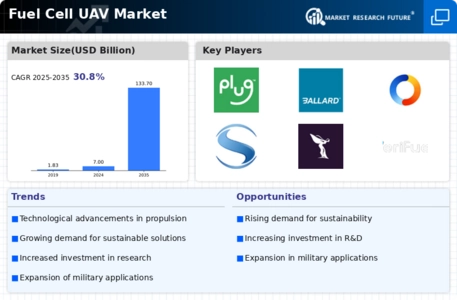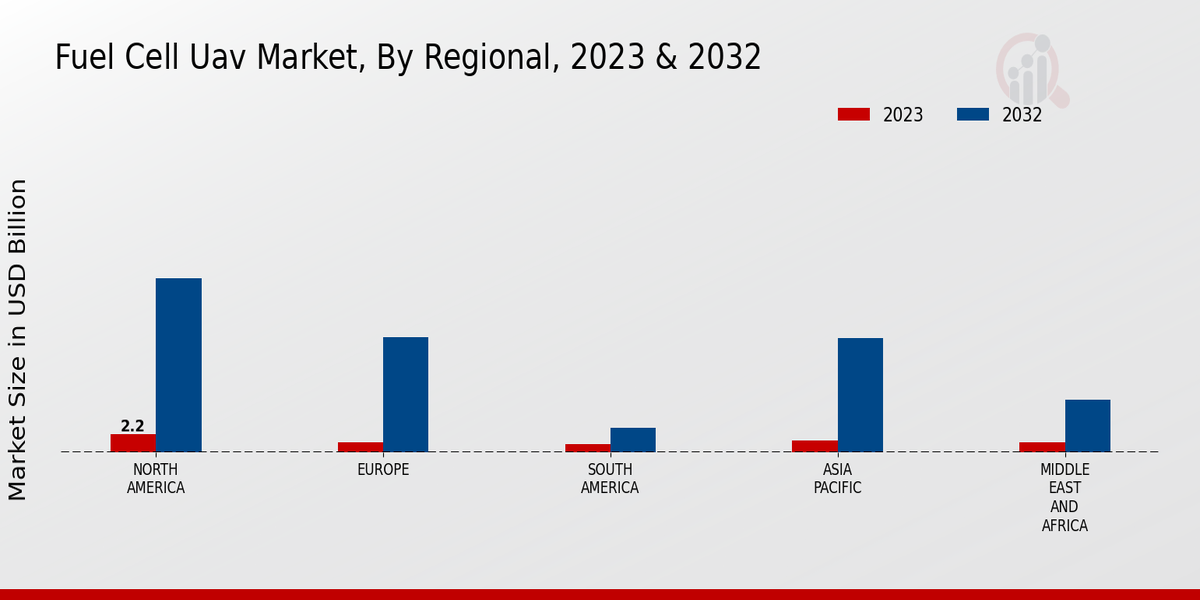Market Growth Projections
The Global Fuel Cell UAV Market Industry is projected to experience substantial growth over the next decade. With a market value of 7 USD Billion in 2024, it is anticipated to reach 133.7 USD Billion by 2035. This growth trajectory reflects the increasing adoption of fuel cell technology across various sectors, driven by advancements in efficiency and sustainability. The compound annual growth rate (CAGR) of 30.75% from 2025 to 2035 underscores the potential for innovation and expansion within the market, highlighting the importance of fuel cell UAVs in future applications.
Military and Defense Applications
The Global Fuel Cell UAV Market Industry is significantly influenced by the increasing demand for UAVs in military and defense applications. Fuel cell technology offers extended flight times and operational ranges, which are essential for surveillance and reconnaissance missions. Military organizations are investing in fuel cell UAVs to enhance their capabilities while reducing logistical challenges associated with traditional fuel sources. The strategic advantages provided by these UAVs are likely to drive market growth, as defense budgets continue to allocate funds for advanced technologies.
Commercial and Industrial Use Cases
The Global Fuel Cell UAV Market Industry is witnessing a surge in commercial and industrial applications, particularly in sectors such as agriculture, logistics, and infrastructure inspection. Fuel cell UAVs offer longer flight durations and greater payload capacities compared to battery-powered alternatives, making them ideal for tasks that require extended operational periods. For example, in agriculture, these UAVs can efficiently monitor crop health over vast areas. As industries recognize the benefits of fuel cell technology, the market is expected to grow at a compound annual growth rate (CAGR) of 30.75% from 2025 to 2035.
Investment in Research and Development
Investment in research and development is a critical driver for the Global Fuel Cell UAV Market Industry. Governments and private entities are allocating significant resources to explore innovative fuel cell technologies and their applications in UAVs. This focus on R&D is likely to yield breakthroughs that enhance the performance, reliability, and cost-effectiveness of fuel cell systems. As new technologies emerge, they may further stimulate market growth, attracting more stakeholders and fostering competition within the industry.
Technological Advancements in Fuel Cells
The Global Fuel Cell UAV Market Industry is experiencing rapid technological advancements that enhance the efficiency and performance of fuel cells. Innovations in materials and design, such as the development of lightweight and durable components, contribute to improved energy density and operational longevity. For instance, advancements in proton exchange membrane fuel cells (PEMFC) have led to increased power output and reduced weight, making them more suitable for UAV applications. These improvements are crucial as the market is projected to reach 7 USD Billion in 2024, indicating a growing demand for high-performance UAVs powered by fuel cells.
Environmental Regulations and Sustainability
Increasingly stringent environmental regulations worldwide are driving the Global Fuel Cell UAV Market Industry towards sustainable solutions. Governments are implementing policies that favor low-emission technologies, thereby creating a favorable environment for fuel cell UAVs. These UAVs produce only water vapor as a byproduct, aligning with global sustainability goals. As industries seek to reduce their carbon footprints, the adoption of fuel cell technology in UAVs is likely to accelerate. This trend is expected to contribute to the market's growth, with projections indicating a rise to 133.7 USD Billion by 2035.












